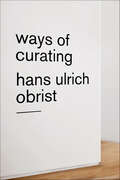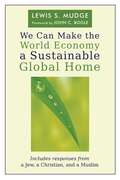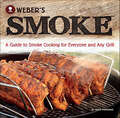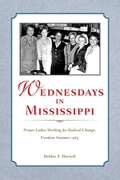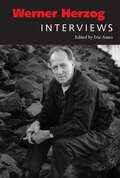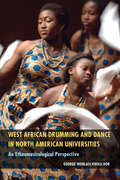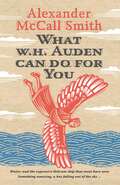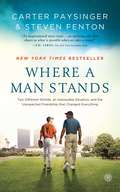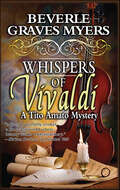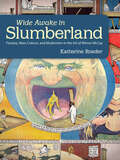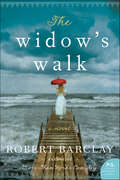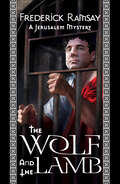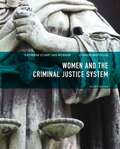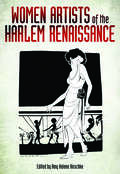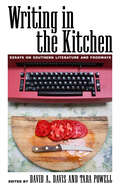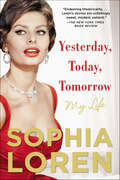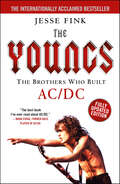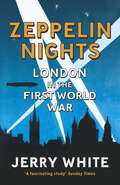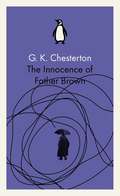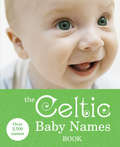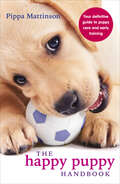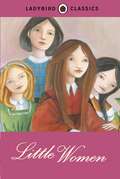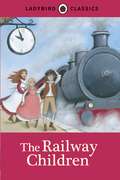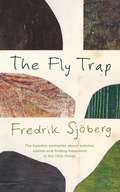- Table View
- List View
Ways of Curating
by Hans Ulrich ObristHans Ulrich Obrist curated his first exhibit in his kitchen when he was twenty-three years old. Since then he has staged more than 250 shows internationally, many of them among the most influential exhibits of our age. Ways of Curating is a compendium of the insights Obrist has gained from his years of extraordinary work in the art world. It skips between centuries and continents, flitting from meetings with the artists who have inspired him (including Gerhard Richter, Louise Bourgeois, and Gilbert and George) to biographies of influential figures such as Diaghilev and Walter Hopps. It describes some of the greatest exhibitions in history, as well as some of the greatest exhibitions never realized. It traces the evolution of the collections from Athanasius Kircher's 17th-century Wunderkammer to modern museums, and points the way for projects yet to come. Hans Ulrich Obrist has rescued the word "curate" from wine stores and playlists to remind us of the power inherent in looking at art—and at the world—in a new way.
We Can Make the World Economy a Sustainable Global Home
by Lewis S. MudgeThis book by theologian-ethicist Lewis Mudge offers fresh philosophical and theological concepts, economic and political insights, and practical financial proposals to counter the causes and lasting effects of the worldwide recession that began in late 2007.The historical and global dimensions of Mudge’s perspective and his open-ended suggestions keep the book’s arguments highly relevant today, little affected by daily changes in a world economy still suffering from the reverberations of the credit collapse several years ago. Editorial references in footnotes provide up-to-date data and add nuances to the major issues raised by Mudge.To help foster the ecumenical dialogue Mudge calls for, We Can Make the World Economy a Sustainable Global Home includes responses from Elliott N. Dorff, John C. Knapp, and Djamel Eddine Laouisset — a Jew, a Christian, and a Muslim.
The Weaver's Companion
by Marilyn MurphyAll the basics of weaving are provided in this succinct handbook. Filled with definitions and illustrations, the book invites weavers to refer to it as they work.
Weber's Smoke: A Guide to Smoke Cooking for Everyone and Any Grill
by Jamie PurvianceIf you can grill, you can smoke!Now you can add smoke flavor to almost any food on any grill. Weber's Smoke shows you how and inspires you with recipes that range from the classic (Best-on-the-Block Baby Back Ribs) to the ambitious (Smoked Duck and Cherry Sausages). And best of all, many of the recipes let you achieve mouthwatering smoke flavor in a matter of minutes-not hours.You'll learn:Basic and advanced smoke cooking methods for traditional smokers as well as standard backyard grillsOver 85 exciting recipes such as Brined and Maple-Smoked Bacon and Cedar-Planked Brie with Cherry Chutney and Toasted AlmondsSmoking woods' flavor characteristics and food pairing suggestions that complement each distinct type of woodWeber's Top Ten Smoking Tips for getting the best possible results on any grill
Wednesdays in Mississippi: Proper Ladies Working for Radical Change, Freedom Summer 1964
by Debbie Z. HarwellAs tensions mounted before Freedom Summer, one organization tackled the divide by opening lines of communication at the request of local women: Wednesdays in Mississippi (WIMS). Employing an unusual and deliberately feminine approach, WIMS brought interracial, interfaith teams of northern middle-aged, middle- and upper-class women to Mississippi to meet with their southern counterparts. Sponsored by the National Council of Negro Women (NCNW), WIMS operated on the belief that the northern participants' gender, age, and class would serve as an entrée to southerners who had dismissed other civil rights activists as radicals. The WIMS teams' respectable appearance and quiet approach enabled them to build understanding across race, region, and religion where other overtures had failed. The only civil rights program created for women by women as part of a national organization, WIMS offers a new paradigm through which to study civil rights activism, challenging the stereotype of Freedom Summer activists as young student radicals and demonstrating the effectiveness of the subtle approach taken by "proper ladies." The book delves into the motivations for women's civil rights activism and the role religion played in influencing supporters and opponents of the civil rights movement. Lastly, it confirms that the NCNW actively worked for integration and black voting rights while also addressing education, poverty, hunger, housing, and employment as civil rights issues. After successful efforts in 1964 and 1965, WIMS became Workshops in Mississippi, which strived to alleviate the specific needs of poor women. Projects that grew from these efforts still operate today.
Werner Herzog: Interviews (Conversations with Filmmakers Series)
by Eric AmesOver the course of his career, legendary director Werner Herzog (b. 1942) has made almost sixty films and given more than eight hundred interviews. This collection features the best of these, focusing on all the major films, from Signs of Life and Aguirre, the Wrath of God to Grizzly Man and Cave of Forgotten Dreams. When did Herzog decide to become a filmmaker? Who are his key influences? Where does he find his peculiar themes and characters? What role does music play in his films? How does he see himself in relation to the German past and in relation to film history? And how did he ever survive the wrath of Klaus Kinski? Herzog answers these and many other questions in twenty-five interviews ranging from the 1960s to the present. Critics and fans recognized Herzog's importance as a young German filmmaker early on, but his films have attained international significance over the decades. Most of the interviews collected in this volume—some of them from Herzog's production archive and previously unpublished—appear in English for the very first time. Together, they offer an unprecedented look at Herzog's work, his career, and his public persona as it has developed and changed over time.
West African Drumming and Dance in North American Universities: An Ethnomusicological Perspective
by George Worlasi DorMore than twenty universities and twenty other colleges in North America (USA and Canada) offer performance courses on West African ethnic dance drumming. Since its inception in 1964 at both UCLA and Columbia, West African drumming and dance has gradually developed into a vibrant campus subculture in North America. The dances most practiced in the American academy come from the ethnic groups Ewe, Akan, Ga, Dagbamba, Mande, and Wolof, thereby privileging dances mostly from Ghana, Togo, Benin, Senegal, Mali, Guinea, and Burkina Faso. This strong presence and practice of a world music ensemble in the diaspora has captured and engaged the interest of scholars, musicians, dancers, and audiences. In the first-ever ethnographic study of West African drumming and dance in North American universities, the author documents and acknowledges ethnomusicologists, ensemble directors, students, administrators, and academic institutions for their key roles in the histories of their respective ensembles. Dor collates and shares perspectives including debates on pedagogical approaches that may be instructive as models for both current and future ensemble directors and reveals the multiple impacts that participation in an ensemble or class offers students. He also examines the interplay among historically situated structures and systems, discourse, and practice, and explores the multiple meanings that individuals and various groups of people construct from this campus activity. The study will be of value to students, directors, and scholars as an ethnographic study and as a text for teaching relevant courses in African music, African studies, ethnomusicology/world music, African diaspora studies, and other related disciplines.
What W. H. Auden Can Do for You (Writers on Writers #5)
by Alexander McCall SmithBestselling novelist Alexander McCall Smith's charming account of how the poet W. H. Auden has helped guide his life—and how he might guide yours, tooWhen facing a moral dilemma, Isabel Dalhousie—Edinburgh philosopher, amateur detective, and title character of a series of novels by best-selling author Alexander McCall Smith—often refers to the great twentieth-century poet W. H. Auden. This is no accident: McCall Smith has long been fascinated by Auden. Indeed, the novelist, best known for his No. 1 Ladies Detective Agency series, calls the poet not only the greatest literary discovery of his life but also the best of guides on how to live. In this book, McCall Smith has written a charming personal account about what Auden has done for him—and what he just might do for you.Part self-portrait, part literary appreciation, the book tells how McCall Smith first came across the poet's work in the 1970s, while teaching law in Belfast, a violently divided city where Auden's "September 1, 1939," a poem about the outbreak of World War II, strongly resonated. McCall Smith goes on to reveal how his life has related to and been inspired by other Auden poems ever since. For example, he describes how he has found an invaluable reflection on life's transience in "As I Walked Out One Evening," while "The More Loving One" has provided an instructive meditation on unrequited love. McCall Smith shows how Auden can speak to us throughout life, suggesting how, despite difficulties and change, we can celebrate understanding, acceptance, and love for others.An enchanting story about how art can help us live, this book will appeal to McCall Smith's fans and anyone curious about Auden.
Where a Man Stands: Two Different Worlds, an Impossible Situation, and the Unexpected Friendship that Changed Everything
by Carter Paysinger Steven FentonWhen Beverly Hills High School welcomed a skinny boy from the other side of the tracks, no one knew just how life-changing the decision would be, not just for Carter Paysinger but for all of Beverly Hills.Carter grew up hearing his parents say, “Don’t just strive to be good. Always strive to be great.” He dreamed of finding greatness in playing professional baseball or becoming a black Donald Trump, but fate had different plans and, ultimately, he found his calling as a teacher and coach at the school that once embraced him, becoming a rock for the innumerable kids who came seeking an ear to listen or a shoulder to cry on. One such kid, a scrappy Jewish boy from a prominent family, would change the course of Carter’s life. His name was Steven Fenton.Twenty years later, as Beverly Hills High fell into disarray—with principals hired and fired and families fleeing the school—as well as his own life coming apart, Carter ran into Steven Fenton again. Together, they found renewed passion and hope to fight for their school and test the limits of what community means. But when Steven convinced Carter to throw his hat into the ring as principal, the progressive Beverly Hills suddenly thought that its winningest and most beloved coach didn’t fit the profile for the Beverly Hills image. It was the beginning of a long road, but Carter could hear his father saying, “Don’t listen to those voices. Do what you have to do.” Filled with hope, triumph, and the struggles that come to define us, Where a Man Stands is a beautiful fish-out-of-water story about the families formed in unlikely places and how, in the end, where you stand, and with whom, and for what, matters as much as anything.
Whispers of Vivaldi (Tito Amato Series)
by Beverle Graves MyersVenice, 1745, is an age of reckless pleasures, playful artifice, and baroque excess. An accident has reduced Tito Amato's glorious singing voice to a husky croak. But now the male soprano is determined to prove himself as a director. As the Teatro San Marco is losing subscribers to a rival company, the theater's Maestro Torani charges Tito with locating the perfect opera to fill the seats in time for Carnival.Surprisingly, a second-rate composer provides the very thing—an opera so replete with gorgeous melodies the public speculates it was written by the late Antonio Vivaldi. Even more disconcerting are the rumors swirling around Angeletto, a male soprano imported from Naples to sing the lead. Is the singer truly a castrato or a female soprano engaging in a daring but lucrative masquerade?Both matters turn dangerous when Maestro Torani is viciously attacked and killed. And Tito is the prime suspect. His own life as well as the future of Teatro San Marco now depend on his skills as a sleuth....
Wide Awake in Slumberland: Fantasy, Mass Culture, and Modernism in the Art of Winsor McCay (Tom Inge Series on Comics Artists)
by Katherine RoederCartoonist Winsor McCay (1869-1934) is rightfully celebrated for the skillful draftmanship and inventive design sense he displayed in the comic strips Little Nemo in Slumberland and Dream of the Rarebit Fiend. McCay crafted narratives of anticipation, abundance, and unfulfilled longing. This book explores McCay's interest in dream imagery in relation to the larger preoccupation with fantasy that dominated the popular culture of early twentieth-century urban America. McCay's role as a pioneer of early comics has been documented; yet, no existing study approaches him and his work from an art historical perspective, giving close readings of individual artworks while situating his output within the larger visual culture and the rise of modernism. From circus posters and vaudeville skits to department store window displays and amusement park rides, McCay found fantastical inspiration in New York City's burgeoning entertainment and retail districts. Wide Awake in Slumberland connects McCay's work to relevant children's literature, advertising, architecture, and motion pictures in order to demonstrate the artist's sophisticated blending and remixing of multiple forms from mass culture. Studying this interconnection in McCay's work and, by extension, the work of other early twentieth-century cartoonists, Roeder traces the web of relationships connecting fantasy, leisure, and consumption. Readings of McCay's drawings and the eighty-one black-and-white and color illustrations reveal a man who was both a ready participant and an incisive critic of the rising culture of fantasy and consumerism.
The Widow's Walk: A Novel
by Robert BarclayIn the spirit of The Notebook and The Time Traveler’s Wife comes Robert Barclay’s haunting and romantic novel of passion, destiny, loss and an eternal love that will bring two people together across time.His name was Garrett Richmond and he had always wanted to live by the ocean. So when the opportunity to buy—and renovate—the old home known as Seaside arrived, he leapt at the chance. Never mind that his friends and family thought he was crazy, he knew he could return this lonely mansion, worn by time, wind, and neglect, to its former beauty. But Seaside was more than just a project; it was spot that had called to him his entire life.And then one night he saw her . . .Her name is Constance Elizabeth Canfield and she tells him Seaside has been her home for over 150 years. But Constance is no ghost; rather, she claims that she has been somehow magically trapped between this life and the next. At first, Garrett can’t believe her crazy story—the woman had to be lying! And yet, there was something about Constance that was from another time . . .Soon this mysterious woman and flesh and blood man share a closeness they cannot deny. But just as their love begins to bloom, Constance’s presence starts mysteriously fading away, soon to be gone forever. Is their love doomed—or is it strong enough to transcend time, and even death itself?
The Wolf and the Lamb (Jerusalem Mysteries #3)
by Frederick RamsayIt's Passover. Gamaliel and his physician friend, Loukas, are crime-solving a third time—reluctantly. Pontius Pilate has been accused of murder. He denies the crime. If convicted, he might escape death but would be removed from Judea. Those rejoicing urge the Rabban to mind his own business. But Gamaliel is a just man which is, as Pilate says to him, "your weakness and also your strength."Knowing that exonerating the Roman could cost him his position, possibly his life, Gamaliel, as would Sherlock Holmes centuries later, examines evidence and sorts through tangled threads, teasing out suspects who include assassins, Roman nobles, Pilate's wife, rogue legionnaires, slaves, servants, and thespians. Unusually, justice triumphs over enmity. Gamaliel is satisfied, High Priest Caiaphas is irate, Loukas accepts an apprentice from Tarsus, and few notice the events of what will later be known as Easter.Ramsay's plausible narrative answers some questions which have puzzled Biblical scholars for centuries. Why did Pilate hear the case against Jesus? Why invent a tradition that required one prisoner be released at Passover? And we ask, why could Caiaphas not heed Gamaliel's warnings not to martyr the man?
Women And The Criminal Justice System
by Katherine Van Wormer Clemens BartollasAn empowerment approach to women in the criminal justice system. Women and the Criminal Justice System, Fourth Edition, presents an up-to-date analysis of women as victims of crime, as offenders, and as professionals in the justice system. The text features an empowerment approach is unified by underlying themes of the intersection of gender, race, and class; and evidence-based research. Personal narratives highlight the information provided to help students connect the text material with real-life situations. An emphasis on critical thinking teaches students to look beyond media hype concerning female offenders to study the real stories behind women affected by and working in the justice system.
Women Artists of the Harlem Renaissance
by Amy Helene KirschkeWomen artists of the Harlem Renaissance dealt with issues that were unique to both their gender and their race. They experienced racial prejudice, which limited their ability to obtain training and to be taken seriously as working artists. They also encountered prevailing sexism, often an even more serious barrier. Including seventy-two black-and-white illustrations, this book chronicles the challenges of women artists, who are in some cases unknown to the general public, and places their achievements in the artistic and cultural context of early twentieth-century America. Contributors to this first book on the women artists of the Harlem Renaissance proclaim the legacy of Edmonia Lewis, Meta Vaux Warrick Fuller, Augusta Savage, Selma Burke, Elizabeth Prophet, Lois Maillou Jones, Elizabeth Catlett, and many other painters, sculptors, and printmakers. In a time of more rigid gender roles, women artists faced the added struggle of raising families and attempting to gain support and encouragement from their often-reluctant spouses in order to pursue their art. They also confronted the challenge of convincing their fellow male artists that they, too, should be seen as important contributors to the artistic innovation of the era.
Writing in the Kitchen: Essays on Southern Literature and Foodways
by Clayton BrumbyScarlett O'Hara munched on a radish and vowed never to go hungry again. Vardaman Bundren ate bananas in Faulkner's Jefferson, and the Invisible Man dined on a sweet potato in Harlem. Although food and stories may be two of the most prominent cultural products associated with the South, the connections between them have not been thoroughly explored until now. Southern food has become the subject of increasingly self-conscious intellectual consideration. The Southern Foodways Alliance, the Southern Food and Beverage Museum, food-themed issues of Oxford American and Southern Cultures, and a spate of new scholarly and popular books demonstrate this interest. Writing in the Kitchen explores the relationship between food and literature and makes a major contribution to the study of both southern literature and of southern foodways and culture more widely. This collection examines food writing in a range of literary expressions, including cookbooks, agricultural journals, novels, stories, and poems. Contributors interpret how authors use food to explore the changing South, considering the ways race, ethnicity, class, gender, and region affect how and what people eat. They describe foods from specific southern places such as New Orleans and Appalachia, engage both the historical and contemporary South, and study the food traditions of ethnicities as they manifest through the written word.
Yesterday, Today, Tomorrow: My Life
by Sophia LorenIn her first memoir, the Academy Award–winning actress Sophia Loren tells her incredible life story from the struggles of her childhood in war-torn Naples to her life as a screen legend, icon of elegance, and devoted mother.In her acting career spanning more than six decades, Sophia Loren became known for her striking beauty and dramatic roles with famed costars Cary Grant, Frank Sinatra, Marlon Brando, Gregory Peck, Jack Lemmon, and Paul Newman. The luminous Italian movie star was the first artist to win an Oscar for a foreign language performance, after which she continued a vibrant and varied career that took her from Hollywood to Paris to Italy—and back to Hollywood. In Yesterday, Today, and Tomorrow, Loren shares vivid memories of work, love, and family with winning candor.Born in 1934 and growing up in World War II Italy, Loren’s life of glamour and success was preceded by years of poverty and hardship, when she lived in her grandparents’ house with her single mother and sister, and endured near starvation. She shares how she blossomed from a toothpick-thin girl into a beautiful woman seemingly overnight, getting her start by winning a beauty pageant; and how her first Hollywood film, The Pride and the Passion, ignited a high-profile romance with Cary Grant, who would vie with her mentor, friend, frequent producer, and lover Carlo Ponti to become her husband. Loren also reveals her long-held desire to become a mother, the disappointments she suffered, the ultimate joy of having two sons, and her happiness as a mother and grandmother.From trying times to triumphant ones, this scintillating autobiography paints a multi-dimensional portrait of the woman behind the celebrity, beginning each chapter with a letter, photograph, or object that prompts her memories. In Loren’s own words, this is a collection of “unpublished memories, curious anecdotes, tiny secrets told, all of which spring from a box found by chance, a precious treasure trove filled with emotions, experiences, adventures.” Her wise and candid voice speaks from the pages with riveting detail and sharp humor. Yesterday, Today, and Tomorrow is as elegant, entrancing, and memorable as Sophia Loren herself.
The Youngs: The Brothers Who Built AC/DC
by Jesse FinkThe Youngs: The Brothers Who Built AC/DC is unlike any AC/DC book you've read before. Less a biography, more a critical appreciation, it tells the story of the trio through 11 classic rock songs and reveals some of the personal and creative secrets that went into their making.Important figures from AC/DC's long way to the top open up for the very first time, while unsung heroes behind the band's success are given the credit they are due. Accepted accounts of events are challenged while sensational new details emerge to cast a whole new light on the band's history—especially their early years with Atlantic Records in the United States. Former AC/DC members and musicians from bands such as Guns N' Roses, Dropkick Murphys, Airbourne and Rose Tattoo also give their take on the Youngs' brand of magic.Their music has never pulled its punches. Neither does The Youngs. After 40 years, AC/DC might just have gotten the serious book it deserves.
Zeppelin Nights: London in the First World War
by Jerry White‘Zeppelin Nights is social history at its best… White creates a vivid picture of a city changed forever by war’ The Times2018 marks the centenary of the end of the First World War. In those four decisive years, London was irrevocably changed. Soldiers passed through the capital on their way to the front and wounded men were brought back to be treated in London’s hospitals. At night, London plunged into darkness for fear of Zeppelins that raided the city. Meanwhile, women escaped the drudgery of domestic service to work as munitionettes. Full employment put money into the pockets of the poor for the first time. Self-appointed moral guardians seize the chance to clamp down on drink, frivolous entertainment and licentious behaviour. Even against a war-torn landscape, Londoners were determined to get on with their lives, firmly resolved not to let Germans or puritans spoil their enjoyment. Peopled with patriots and pacifists, clergymen and thieves, bluestockings and prostitutes, Jerry White’s magnificent panorama reveals a battle-scarred yet dynamic, flourishing city.‘Jerry White's name on a title page is a guarantee of a lively, compassionate book full of striking incidents and memorable images… This is a fast-paced social history that never stumbles… A well-orchestrated polyphony of voices that brings history alive’ Guardian
The Innocence of Father Brown
by G K ChestertonThis is the first volume of Chesterton's brilliant, ingenious Father Brown stories. Ahead of a new series of the popular BBC adaptation starring Mark Williams, all five of the original Father Brown books have been republished with charming and collectible Penguin covers. With his round face, pipe and umbrella, the shambling, bespectacled priest Father Brown is an unlikely detective - yet his innocent air hides a razor-sharp understanding of the criminal mind. As this first volume of his adventures shows, the wise, worldly clerical sleuth has an uncanny ability to bring even the most elusive wrongdoer to justice.G. K. Chesterton was born in 1874. He attended the Slade School of Art, where he appears to have suffered a nervous breakdown, before turning his hand to journalism. A prolific writer throughout his life, his best- known books include The Napoleon of Notting Hill (1904), The Man Who Knew Too Much (1922), The Man Who Was Thursday (1908) and the Father Brown stories. Chesterton converted to Roman Catholicism in 1922 and died in 1938.
The Celtic Baby Names Book
by VariousThere is currently a huge resurgence of interest in genealogy and in searching out one's roots. People are keen to delve back to early civilisations from which family ancestors came, hence the fascination with all things Celtic. Drawn from legend, place names, mythology and history, Celtic names reflect the magic and charm of the isles they come from: Ireland, Wales, Scotland, Cornwall, and even Spain and Italy. This unique, enchanting guide draws on Celtic history and culture to provide expectant parents with over 2,500 beautiful, one-of-a-kind Celtic names. Divided by sex with Gaelic spellings and name variations, as well as the origins and meanings of names, The Celtic Baby Names Book is a fun, comprehensive guide to Celtic names.
The Happy Puppy Handbook: Your Definitive Guide to Puppy Care and Early Training
by Pippa MattinsonPippa Mattinson, dog-training specialist, tells you everything you need to know about training and caring for your new puppy. From preparing the house and garden before the puppy arrives, to introducing your new friend to all the family (including children and other animals), and solving problems like crying, night waking, feeding, upset stomachs, biting, chewing and jumping up, this book is packed with all you need to know as a puppy owner.
Ladybird Classics: Little Women
by Louisa May AlcottThis Ladybird Classic is an abridged retelling of the classic story of Little Women by Louisa May Alcott, making it perfect for introducing the story to younger children, or for newly confident readers to tackle alone.Beautiful new illustrations throughout bring the magic of this classic story to a new generation of children.
Ladybird Classics: The Railway Children
by E. NesbitThis Ladybird Classic is an abridged retelling of the classic story of The Railway Children by Edith Nesbit, making it perfect for introducing the story to younger children, or for newly confident readers to tackle alone.Beautiful new illustrations throughout bring the magic of this classic story to a new generation of children.
The Fly Trap
by Fredrik SjöbergFredrik Sjöberg's Swedish bestseller about summer, islands, freedom and boundaries.'The light, the warmth, the smells, the mist, the birdsong - the moths. Who can sleep? Who wants to?'Fredrik Sjöberg finds happiness in the little things. Millions of them, in fact. This beguiling bestseller is his unique meditation on collecting hoverflies. It is also about living on a remote Swedish island, blissful long summer nights, lost loves, unexpected treasures, art, nature, slowness, and how freedom can come from the things we least expect.'Full of charm, a book about how to find meaning in life' Melissa Harrison, The Times, Books of the Year'I often return to The Fly Trap, it remains close to my heart. The minute observations from nature that reveal sudden insights into one's life. Sometimes I almost think that he wrote it for me' Tomas Tranströmer, winner of the Nobel Prize in Literature'Charming, witty and original' Patrick Barkham, Guardian 'Nature writing that can laugh at itself, a real tonic' Gregory Day, Sydney Morning Herald'Delightful, at once informative and often humorously digressive . . . a humane man of wide-ranging curiosity, Sjöberg writes with infectious passion' Paul Binding IndependentFredrik Sjöberg collects hoverflies on the island Runmarö, in the archipelago east of Stockholm. He is also a literary critic, translator, cultural columnist and the author of several books including The Art of Flight and The Raisin King, which form a trilogy with The Fly Trap.
